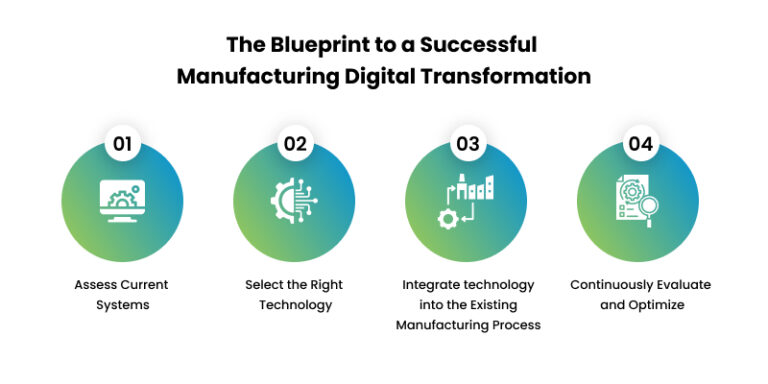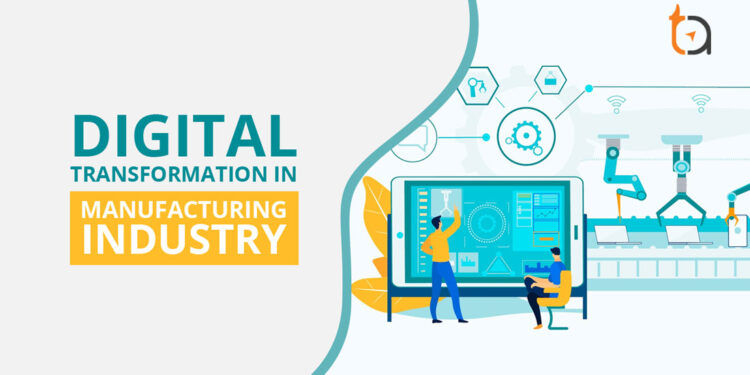DigiLife Digital Transformation for Manufacturing sets the stage for this enthralling narrative, offering readers a glimpse into a story that is rich in detail and brimming with originality from the outset.
As we delve into the realm of digital transformation in manufacturing, we uncover the key components, benefits, and challenges that shape this evolving landscape.
Overview of DigiLife Digital Transformation for Manufacturing
DigiLife Digital Transformation in the manufacturing sector refers to the integration of digital technologies into various aspects of manufacturing processes to enhance efficiency, productivity, and innovation. This transformation involves leveraging advanced technologies such as Internet of Things (IoT), Artificial Intelligence (AI), Big Data Analytics, and Automation to streamline operations and drive growth in the industry.
Key Components of DigiLife Digital Transformation
- Integration of IoT devices to monitor and optimize production processes in real-time.
- Utilization of AI and Machine Learning algorithms for predictive maintenance and quality control.
- Implementation of Big Data Analytics to derive actionable insights for decision-making.
- Automation of repetitive tasks and workflows to improve operational efficiency.
Benefits of Implementing DigiLife Digital Transformation in Manufacturing
- Enhanced operational efficiency and productivity through automation and real-time monitoring.
- Improved product quality and consistency by leveraging AI for quality control.
- Cost savings through predictive maintenance and optimized resource utilization.
- Increased flexibility and agility to adapt to changing market dynamics and customer demands.
Examples of Successful DigiLife Digital Transformation Initiatives
One notable example of successful DigiLife Digital Transformation in manufacturing is Siemens AG, which implemented IoT sensors and analytics to optimize its production processes, resulting in increased productivity and reduced downtime. Another example is General Electric (GE), which utilized AI-powered predictive maintenance to improve equipment reliability and reduce maintenance costs significantly.
Technologies Driving DigiLife Digital Transformation in Manufacturing

IoT, AI, Big Data, and Cloud Computing are key technologies enabling digital transformation in the manufacturing sector. These technologies play a crucial role in enhancing efficiency, productivity, and decision-making processes within the DigiLife framework.
Internet of Things (IoT)
IoT involves connecting physical devices and sensors to gather data and communicate over a network. In manufacturing, IoT enables real-time monitoring of equipment, predictive maintenance, and seamless integration of systems. By harnessing IoT, manufacturers can achieve improved operational visibility, increased automation, and enhanced efficiency throughout the production process.
Artificial Intelligence (AI)
AI technologies like machine learning and predictive analytics empower manufacturers to optimize production processes, predict maintenance needs, and enhance product quality. AI algorithms analyze vast amounts of data to identify patterns, trends, and anomalies, enabling proactive decision-making and continuous improvement in manufacturing operations within the DigiLife ecosystem.
Big Data and Analytics
Big Data and Analytics solutions enable manufacturers to extract valuable insights from large datasets generated by IoT devices and other sources. By leveraging advanced analytics tools, manufacturers can identify opportunities for cost reduction, quality improvement, and operational optimization. Data-driven decision-making is at the core of DigiLife Digital Transformation, facilitating agile responses to market demands and changing conditions.
Cloud Computing
Cloud Computing provides manufacturers with scalable and flexible infrastructure to store, process, and analyze data in a secure environment. By migrating to the cloud, manufacturers can access powerful computing resources, collaborate seamlessly, and deploy innovative applications for process optimization and business intelligence.
Cloud-based solutions support the digital transformation journey by enabling remote access, real-time data sharing, and enhanced connectivity across the manufacturing ecosystem.
Challenges and Solutions in Implementing DigiLife Digital Transformation

Implementing DigiLife Digital Transformation in the manufacturing sector can be a complex process, often met with various challenges that need to be addressed strategically for successful adoption. Let's delve into some common challenges faced by manufacturing companies and explore effective solutions to overcome these hurdles.
Resistance to Change
One of the primary challenges in implementing digital transformation in manufacturing is resistance to change from employees and stakeholders. Many individuals may be hesitant to embrace new technologies, fearing job displacement or unfamiliar processes.
- Engage employees early on: Involving employees in the decision-making process and emphasizing the benefits of digital transformation can help alleviate resistance.
- Provide training and support: Offering comprehensive training programs and ongoing support can empower employees to adapt to new technologies with confidence.
- Communicate effectively: Clear communication about the reasons for digital transformation and its positive impact on the organization can foster a culture of openness and collaboration.
Cybersecurity Risks
With the increasing adoption of digital technologies in manufacturing, cybersecurity risks have become a significant concern. Protecting sensitive data and ensuring the integrity of systems is crucial to the success of digital transformation initiatives.
- Implement robust cybersecurity measures: Utilize encryption, access controls, and regular security audits to safeguard critical information from cyber threats.
- Train employees on cybersecurity best practices: Educate staff on recognizing and responding to potential security threats to mitigate risks effectively.
- Partner with trusted cybersecurity experts: Collaborating with cybersecurity professionals can provide valuable insights and guidance on strengthening your digital defense mechanisms.
Smooth Transition Best Practices
Transitioning to DigiLife Digital Transformation requires careful planning and execution to ensure a seamless integration of new technologies and processes.
- Set clear goals and objectives: Define specific goals for digital transformation initiatives and establish key performance indicators to measure success.
- Start small and scale up: Begin with pilot projects to test new technologies and processes before implementing them on a larger scale across the organization.
- Foster a culture of innovation: Encourage a culture that values experimentation, learning from failures, and continuous improvement to drive successful digital transformation.
Future Prospects and Trends in DigiLife Digital Transformation for Manufacturing
As DigiLife Digital Transformation continues to revolutionize the manufacturing industry, several future prospects and trends are emerging that will shape the way businesses operate and grow.
Blockchain Integration and 3D Printing
The integration of blockchain technology into DigiLife Digital Transformation for manufacturing processes is expected to enhance supply chain transparency, traceability, and security. Additionally, the widespread adoption of 3D printing technologies will enable more agile and customizable production capabilities, reducing lead times and costs.
Automation and Robotics
- Automation and robotics are poised to play a significant role in the future of manufacturing within the DigiLife framework. These technologies will streamline production processes, increase efficiency, and improve overall productivity.
- Robots equipped with advanced AI algorithms will be able to perform complex tasks with precision, leading to a more seamless integration of human workers and machines on the factory floor.
Sustainability and Eco-friendly Practices
- The increasing focus on sustainability and eco-friendly practices will drive the future of DigiLife Digital Transformation for manufacturing. Companies will need to adopt green technologies, reduce waste, and optimize energy consumption to meet regulatory requirements and consumer demands.
- Implementing circular economy principles and incorporating renewable energy sources will not only benefit the environment but also improve brand reputation and attract environmentally-conscious customers.
Final Thoughts

In conclusion, DigiLife Digital Transformation for Manufacturing embodies the future of the industry, paving the way for innovation, efficiency, and sustainability. As technology continues to advance, so too will the possibilities within manufacturing, guided by the transformative power of DigiLife.














